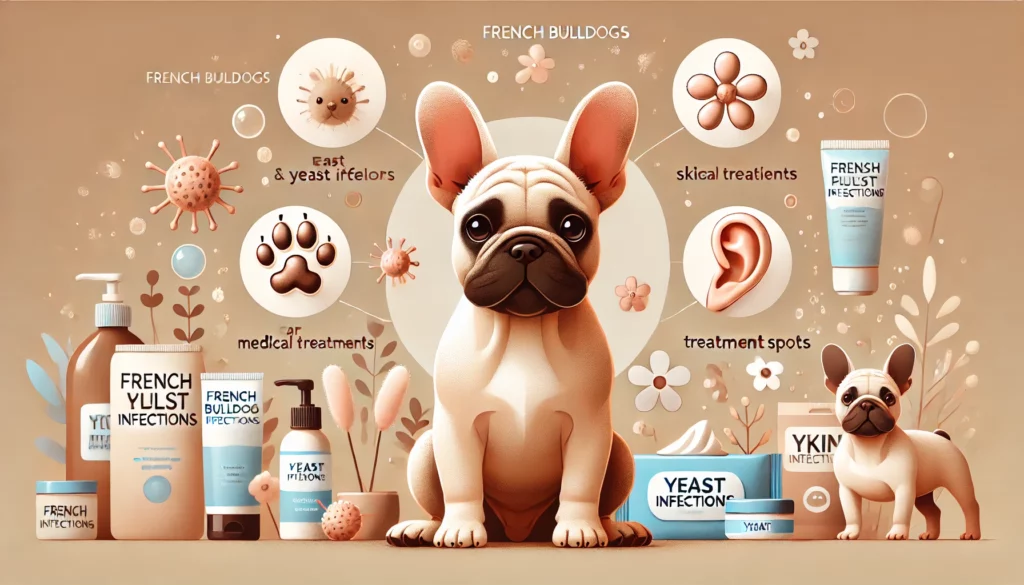Yeast Infections & Your French Bulldogs
Causes, Treatments, and Prevention
Our little baby frenchies, with their charming personalities and distinct appearances, are not just beloved pets – they are family. And as such, we want them to be as healthy and happy as possible. However, their unique physiology makes them susceptible to some very specific health issues, unfortunately that includes yeast infections. In this article we will delve into the causes of yeast infections in French Bulldogs, where they might occur, and – of course – how to treat them.
What is a Yeast Infection Anyway?
Yeast infections (aka: candidiasis) are caused by the overgrowth of yeast (aka: Candida) – imagine that! Yeast is a very specific type of fungus. To specify further – Malassezia is the genus which is the most common culprit when it comes to canine infections.
Yeast naturally resides on the surface of the skin; typically where there is an excessive amount of fat to feed on – which is often right where sebaceous glands are found. Unfortunately, for our furry little buddies, sometimes overgrowth occurs and naturally occurring yeast becomes prone to excessively proliferation. Problems may exacerbate further if the infection finds a way inside the body as well.
Common Areas Affected in French Bulldogs
- Ears: French Bulldogs’ ears are prone to yeast infections due to their shape, which can trap moisture and debris.
- Paws: The moist environment between the toes is ideal for yeast growth, especially if your dog walks on damp surfaces or sweats a lot from their pads.
- Skin Folds: French Bulldogs have numerous skin folds, particularly around their face and neck. These areas can retain moisture and debris, leading to yeast overgrowth.
- Underbelly and Genital Area: These areas are warm and moist, making them another common site for infections.
Treating Yeast Infections
The treatment approach varies depending on the infection’s location:
(Warning: most antifungal applications are not friendly to the eyes. Read all instructions and warning labels for any medication – whether it was prescribed or purchased OTC)
- Ears:
- Cleaning: Use a vet-recommended ear cleaner to gently clean the ears, removing excess wax and debris where yeast can thrive.
- Medicated Drops: Apply antifungal ear drops prescribed by your vet.
- Paws:
- Foot Baths: Regularly soak your dog’s paws in an antifungal solution or use medicated wipes.
- Keep Dry: Ensure your dog’s paws are thoroughly dried after baths or walks in damp areas.
- Skin Folds:
- Cleaning Routine: Clean the skin folds daily with a soft, damp cloth and a mild antifungal cleaner.
- Barrier Creams: Apply a barrier cream to protect the skin and prevent moisture buildup, as advised by your vet.
- Underbelly and Genital Area:
- Keep Dry and Clean: Regular cleaning and drying are vital to prevent infections.
- Topical Antifungals: Use prescribed topical treatments to deal with infections in these sensitive areas.
When Treatments Don’t Work
If your little frenchie’s yeast infection persists despite treatment, consider the following steps before consulting your vet:
- Review the Diagnosis: Ensure that the issue has been correctly diagnosed as a yeast infection. Similar symptoms can result from allergies or other infections.
- Adherence to Treatment: Confirm that the treatment protocol has been followed consistently. Inconsistent treatment can lead to recurrence or persistence of the infection.
- Dietary Changes: Consider changing your pet’s diet. Some diets can influence the skin’s oil production and overall health, affecting yeast growth.
- Environmental Adjustments: Look at your environment to eliminate factors that may contribute to yeast growth, such as high humidity.
When to See the Vet
If the infection does not improve or if it worsens, it’s crucial to consult your veterinarian. They may suggest:
- Advanced Treatments: Stronger medications or alternative therapies.
- Testing for Underlying Causes: Sometimes, persistent infections are due to underlying health issues like hormonal imbalances or immune system disorders.
- Comprehensive Review: A thorough review of your pet’s overall health, lifestyle, and environment to identify any contributing factors.
Conclusion
Yeast infections can be a troublesome issue for French Bulldogs but managing them effectively is possible with the right knowledge and care. Regular cleaning, proper medication, and keeping affected areas dry are key to treatment. If your dog suffers from recurrent yeast infections, it may indicate an underlying condition that requires professional attention. Always consult your veterinarian for a tailored approach to ensure your French Bulldog remains healthy and comfortable.
